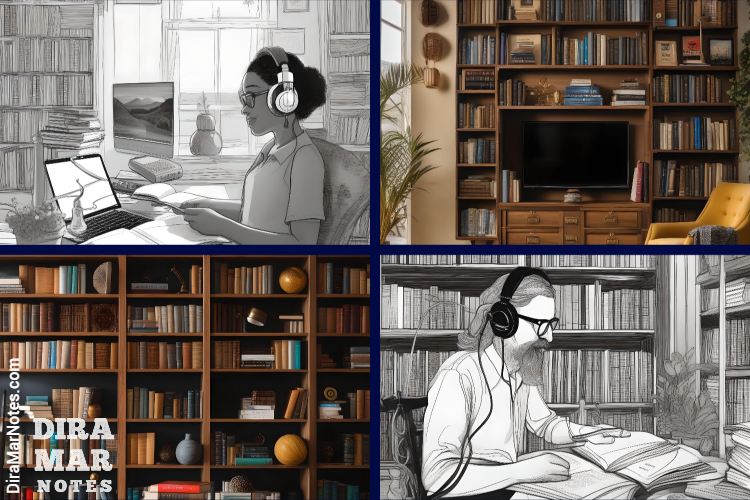
THE EMERGENCE OF “BOOKS AS DECOR”
In today’s digital age, it’s common to find people proudly expressing their love for literature online. However, there’s a growing trend known as “books as decor,” where individuals prioritize owning books as a symbol of cultural capital rather than reading them.
LITERARY ENGAGEMENTS
Many studies and surveys suggest that people often watch TV or film adaptations of books before ever picking up the actual book. This trend raises questions about the true extent of literary engagement in our society, as consuming media has become more about social status than genuine interest in reading. Here are some examples and observations that illustrate this trend:
BESTSELLER LISTS
Often, when a book is adapted into a successful TV series or movie, its sales skyrocket shortly after the adaptation’s release. This suggests that a significant portion of the audience was introduced to the story through the visual medium before deciding to read the book.
SOCIAL MEDIA DISCUSSIONS
Online platforms like Twitter, Reddit, and Goodreads are filled with conversations about TV and film adaptations of books, with many users expressing interest in reading the source material after enjoying the adaptation.
BOOK SALES DATA
While it’s challenging to attribute book sales solely to individuals who watched the movie adaptation, there is often a noticeable correlation between the release of a popular adaptation and increased sales of the corresponding book.
SURVEYS ON READING HABITS
While not specifically addressing the order in which individuals consume adaptations and books, surveys on reading habits often reveal that many people are influenced by popular media when choosing their next read. This suggests that exposure to adaptations may drive book purchases.
PERSONAL ANECDOTES
Many individuals share personal stories of watching a movie or TV show based on a book and subsequently feeling compelled to read the book to delve deeper into the story or gain a fuller understanding of the characters and plot.
While this trend may be more pronounced among younger generations, it’s not limited to them. Even millennials, who grew up in an era dominated by TV and movies, can attest to the allure of visual storytelling over traditional literature. Access to fictional books was often limited.
My library was mostly filled with nonfictional books and had a limited variety of fictional stories. Bookstores offer them at premium prices compared to nonfictional counterparts making them largely inaccessible or perceived as too costly for parents with a limited income. I used to take side jobs as a kid to save and buy toys and books. In many countries, most Movies and TV shows were translated and broadcasted on national television which broadened its availability to be watched by many people in contrast to cable TV.

THE RISE OF AUDIOBOOKS
On the other hand, the rise of audiobooks has transformed the reading experience, making literature more accessible to a broader audience. It has revolutionized the way people consume literature, transforming the act of “reading” into a multifaceted experience.
With audiobooks, individuals can immerse themselves in a story simply by listening, whether during their daily commute, while exercising, or even while doing household chores. This accessibility has opened up a world of literature to a broader audience, including those who may have previously struggled to find the time or motivation to sit down and read a physical book. As a result, the audiobook phenomenon has democratized literature, making it more inclusive and accessible to people from all walks of life.
Moreover, audiobooks offer a unique storytelling experience that goes beyond traditional reading. Narrators infuse characters with personality through their voices, bringing the story to life in ways that printed text alone cannot achieve. This dynamic approach to storytelling enhances engagement and allows listeners to form deeper connections with the characters and plot.
Additionally, audiobooks provide a valuable alternative for individuals with visual impairments or learning disabilities, further highlighting their role in expanding access to literature for all. Ultimately, the audiobook phenomena have redefined what it means to “read” a book, blurring the lines between traditional reading and listening while enriching the literary landscape for a modern audience.
READING OR LISTENING?
One significant drawback of audiobooks is the potential for people to pretend they’ve read a book when they’ve only listened to it. Unlike physically reading a book, which requires active engagement and comprehension, listening to an audiobook allows individuals to consume the content passively while multitasking or engaging in other activities.
As a result, some may boast about “reading” a book without fully absorbing its contents or experiencing the cognitive benefits associated with reading. This behavior not only undermines the integrity of personal literary experiences but also perpetuates a culture of superficiality where appearances outweigh genuine engagement with literature.
I have a preference for traditional reading, particularly with lengthy books. I find that I easily get distracted with audiobooks, so having a physical book in front of me that commands my attention is more effective. I’ve noticed that many people claim to have “read” a book when they’ve listened to it, often without fully engaging or paying attention.
FINAL THOUGHTS
Ultimately, the phenomenon of “books as decor” and the rise of audiobooks underscore the evolving nature of literary consumption in the digital age, raising questions about the authenticity of reading habits and the importance of genuine engagement with literature.
As individuals navigate this landscape, it’s essential to prioritize meaningful interactions with books, whether through traditional reading or immersive listening experiences, to ensure a deeper connection with the written word and foster a culture of genuine literary appreciation.



